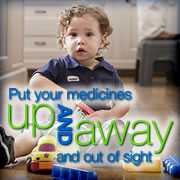The PROTECT Initiative: Advancing Children’s Medication Safety

What is PROTECT?
The PROTECT Initiative is an innovative collaboration bringing together public health agencies, private sector companies, professional organizations, consumer/patient advocates, and academic experts to develop strategies to keep children safe from unintentional medication overdoses. Medication overdoses can lead to harm, sometimes requiring emergency treatment or hospitalization and are a significant public health problem.
Why PROTECT?
Over-the-counter (OTC) and prescription medications are commonly used for people of all ages. This frequency of use increases the potential for unintentional (accidental) overdoses. Children are especially vulnerable to unintentional overdoses, most of which can be prevented. Data from the National Electronic Injury Surveillance System-Cooperative Adverse Event Surveillance System (NEISS-CADES) project estimated that each year in the United States:
- Over 70,000 emergency department (ED) visits result from unintentional medication overdoses among children under the age of 18 [1];
- One out of every 151 two-year-olds is treated in an ED for an unintentional medication overdose [2];
- Over 80% of ED visits among children under the age of 12 are due to unsupervised children taking medications on their own and 10% of ED visits in this age group are due to medication errors [1];
- Over-the-counter medications are involved in approximately one-third of ED visits among children under the age of 12 [1].
Background
In 2008, CDC convened a meeting of public health agencies, the leading manufacturers of OTC medications, medication packaging manufacturers, poison control centers, healthcare professional societies, consumer/patient advocates, and national experts in, poisoning, health literacy and patient safety to share information and expertise on the public health problem of medication overdoses in children. Although the initial focus of the PROTECT Initiative has been on overdoses from OTC medications, successes will guide efforts to reduce unintentional overdoses from prescription medications.
Purpose: To prevent unintentional medication overdoses in children
Measurable Goal: Reduce emergency department visits for unintentional medication overdoses in children
Together, PROTECT participants prioritized several key initiatives to help prevent medication overdoses in children:
- Implement improvements in medication packaging to reduce harm from unsupervised medication ingestions (children accessing and ingesting medication without adult supervision)
- Refine dosing measures on medication packaging and labeling to reduce errors potentially made by parents/caregivers when administering medications
- Identify key messages for an educational campaign to improve safe use of OTC medications by parents/caregivers
- Address key unanswered questions for effective prevention of this public health problem.
Partners/Members
The work of The PROTECT Initiative is driven by the initiative’s members and is composed of the following organizations:
- Government Agencies
- Industry Partners: Pharmaceutical and Medication Packaging Industries
- Non-profit Organizations
- Professional Organizations
- Academic Representatives
Workgroups and Objectives
Currently, the PROTECT Initiative comprises four workgroups:
- Unsupervised Ingestions Workgroup
Initial Objective: Identify innovative strategies by which OTC liquid medication packaging can be improved to minimize or prevent exposure to the medication when young children access and ingest medications on their own. - Medication Errors Workgroup
Initial Objective: Develop recommendations for improving and standardizing how volumetric measures (e.g., teaspoons, mL, ounces) are displayed on OTC liquid medication packaging and labels. - Education Workgroup
Initial Objective: Identify key messages for a national education campaign targeted at improving safe use of OTC medications by parents/caregivers. - Scientific Workgroup
Initial Objective: Identify and answer key questions that remain unanswered about unintentional medication overdoses and that can help guide effective prevention of the public health problem. Top of Page
Results/Accomplishments
To date, as a direct outgrowth of the PROTECT Initiative, the following has been accomplished:
- Fostered development of a Voluntary Guideline for standardizing and clarifying dosing measures for OTC liquid medicines. All members of CHPA participate in developing the association’s voluntary guidelines. The CHPA guideline is consistent with recommendations of the FDA guidance for industry [PDF - 14 pages] on OTC dosage delivery devices, and encourages even further dosing standardization on package labels to reduce caregiver confusion.
- Fostered development of innovative safety packaging, specifically designed to decrease the number and severity of unsupervised ingestions by young children [2]. A number of leading nonprescription drug companies have committed to incorporating new product enhancements for infants’ liquid acetaminophen products beginning in Fall 2011, including new safety packaging for Infant’s and Children’s Tylenol .
- Developed and launched the Up and Away and Out of Sight educational program to remind parents and caregivers of young children about the importance of safe medication storage and what to do in case of an emergency.
- Convened an inaugural meeting of PROTECT-Rx in collaboration with FDA’s Safe Use Initiative to build upon the experiences from PROTECT and to apply them towards the prevention of unintentional overdoses from prescription medications in children.
References
- Schillie SF, Shehab N, Thomas KE, Budnitz DS. Medication overdoses leading to emergency department visits among children . Am J Prev Med 2009;37:181-7.
- Budnitz DS, Salis S. Preventing medication overdoses in young children: an opportunity for harm elimination . Pediatrics 2011;127:e1597-9..
- Page last reviewed: September 28, 2010
- Page last updated: July 17, 2012
- Content source:
- Centers for Disease Control and Prevention
- Page maintained by: Office of Associate Director of Communication, Division of Public Affairs



 ShareCompartir
ShareCompartir